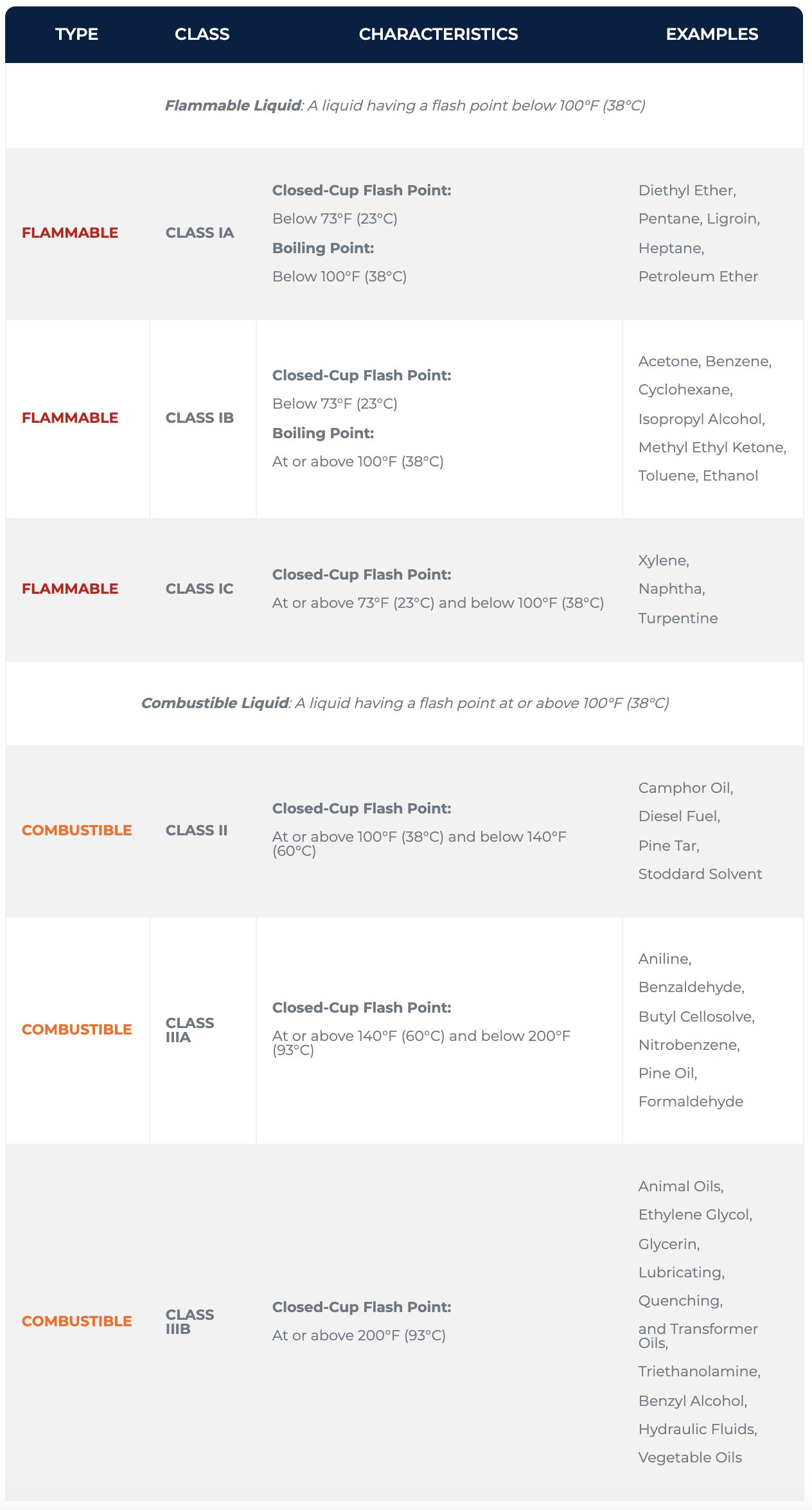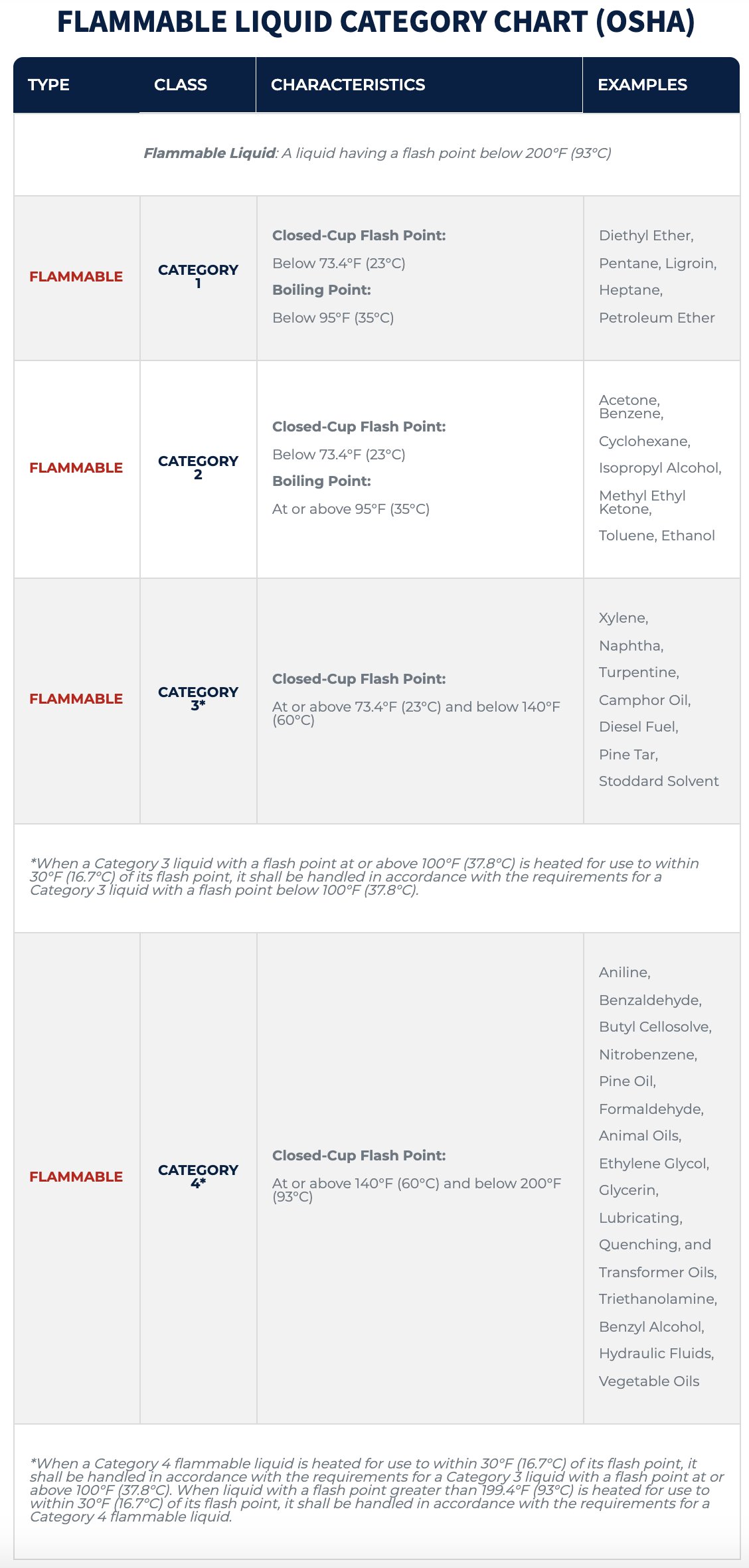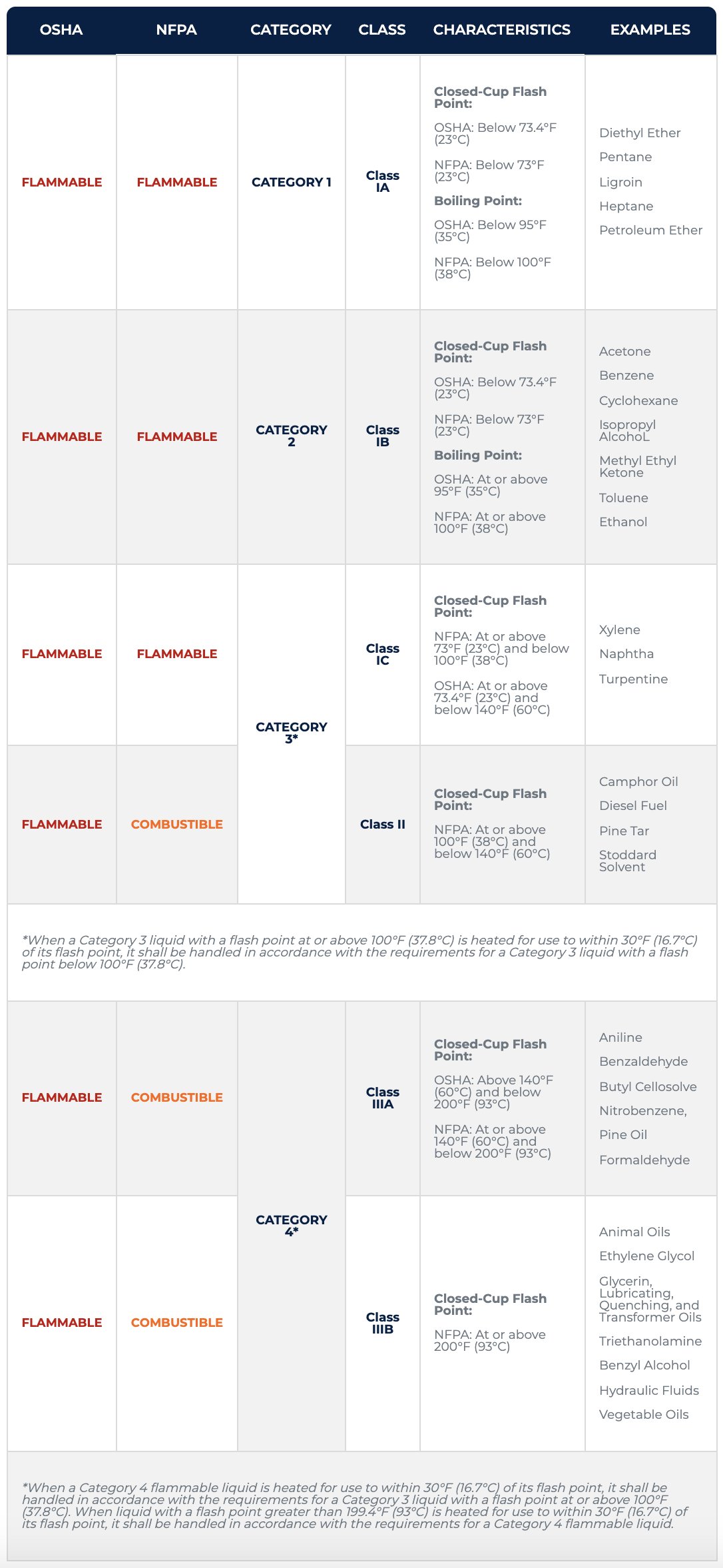- Class IA
- Class IB
- Class IC
- Class II
- Class IIIA
- Class IIIB
- Category 1
- Category 2
- Category 3
- Category 4
TOPICS:
- Flammable Liquid Classes from the National Fire Protection Association (NFPA)
- Flammable Liquid Categories from the Occupational Safety and Health Administration (OSHA)
- [CHART] Flammable Liquid Classes & Categories
- When to Use NFPA’s Flammable Liquid Classes or OSHA’s Flammable Liquid Categories
- Difference Between Flammable Liquid Classes and Categories
[DOWNLOAD] PDF: FLAMMABLE LIQUID CATEGORIES CHART
|
NFPA Flammable Liquid Types |
|
|
Type |
Flash Point Range |
|
Flammable Liquids |
< 100°F (38°C) |
|
Combustible Liquids |
≥ 100°F (38°C) |
Those flammable liquid classes are:
| Class IA | Class IB | Class IC | Class II | Class IIIA | Class IIIB |
Keep in mind that the LOWER the flash point the MORE HAZARDOUS a substance is because it is flammable at a lower temperature. So Class IA is the most volatile.
Let’s breakdown the details of each class with some examples.
Class IA Flammable Liquids
A Class IA flammable liquid is any liquid with a closed-cup flash point below 73°F (23°C) AND with a boiling point below 100°F (38°C).
Examples of Class IA Flammable Liquids include:
- Diethyl Ether
- Pentane
- Ligroin
- Heptane
- Petroleum Ether
Class IB Flammable Liquids
A Class IB flammable liquid is any liquid with a closed-cup flash point below 73°F (23°C) AND with a boiling point at or above 100°F (38°C).
Examples of Class IB Flammable Liquids include:
- Acetone
- Benzene
- Cyclohexane
- Isopropyl Alcohol
- Methyl Ethyl Ketone
- Toluene
- Ethanol
Class IC Flammable Liquids
A Class IC flammable liquid is any liquid with a closed-cup flash point at or above 73°F (23°C) and below 100°F (38°C).
Examples of Class IC Flammable Liquids include:
- Xylene
- Naphtha
- Turpentine
Now we start to get into the transition from flammable liquid to combustible liquids according to NFPA’s definitions.
Class II Combustible Liquids
A Class II combustible liquid is any liquid with a closed-cup flash point at or above 100°F (38°C) and below 140°F (60°C).
Examples of Class II Combustible Liquids include:
- Camphor Oil
- Diesel Fuel
- Pine Tar
- Stoddard Solvent
Class IIIA Combustible Liquids
A Class IIIA combustible liquid is any liquid with a closed-cup flash point at or above 140°F (60°C) and below 200°F (93°C).
Examples of Class IIIA Combustible Liquids include:
- Aniline
- Benzaldehyde
- Butyl Cellosolve
- Nitrobenzene
- Pine Oil
- Formaldehyde
Class IIIB Combustible Liquids
A Class IIIB combustible liquid is any liquid with a closed-cup flash point at or above 200°F (93°C).
Examples of Class IIIB Combustible Liquids include:
- Animal Oils
- Ethylene Glycol
- Glycerin
- Lubricating
- Quenching
- Transformer Oils
- Triethanolamine
- Benzyl Alcohol
- Hydraulic Fluids
- Vegetable Oils
Here is a chart for all of you visual learners that explains the different NFPA flammable liquid classes. Download Chart.
Flammable Liquid Categories from the Occupational Safety and Health Administration (OSHA)
OSHA is a bit different. After the changes to the U.S. Labor Law in 2012, OSHA no longer calls any liquids “combustible”.
They refer to any liquid with a closed-cup flash point below 200°F (93°C) as a “flammable liquid”.
This will be most obvious in OSHA’s CFR29 1910.106 and CFR29 1926.152 where the regulations for flammable liquid handling and storage exist.
|
OSHA Flammable Liquid Types |
|
|
Type |
Flash Point Range |
|
Flammable Liquids |
< 200°F (93°C) |
There are four flammable liquid categories:
| Category 1 | Category 2 | Category 3 | Category 4 |
Category 1 Flammable Liquids
A Category 1 flammable liquid is any liquid with a closed-cup flash point below 73.4°F (23°C) AND with a boiling point below 95°F (35°C).
Examples of Category 1 Flammable Liquids include:
- Diethyl Ether
- Pentane
- Ligroin
- Heptane
- Petroleum Ether
Category 2 Flammable Liquids
A Category 2 flammable liquid is any liquid with a closed-cup flash point below 73.4°F (23°C) AND with a boiling point above 95°F (35°C).
Examples of Category 2 Flammable Liquids include:
- Acetone
- Benzene
- Cyclohexane
- Isopropyl alcohol
- Methyl ethyl ketone
- Toluene
- Ethanol
Category 3 Flammable Liquids
A Category 3 flammable liquid is any liquid with a closed-cup flash point at or above 73.4°F (23°C) AND below 140°F (60°C).
Category 3 has a caveat.
*When a Category 3 liquid with a flash point at or above 100°F (37.8°C) is heated for use to within 30°F (16.7°C) of its flash point, it shall be handled in accordance with the requirements for a Category 3 liquid with a flash point below 100°F (37.8°C).
Examples of Category 3 Flammable Liquids include:
- Xylene
- Naphtha
- Turpentine
- Camphor Oil
- Diesel Fuel
- Pine Tar
- Stoddard Solvent
Category 4 Flammable Liquids
A Category 4 flammable liquid is any liquid with a closed-cup flash point at or above 140°F (60°C) AND below 200°F (93°C).
Category 4 has a caveat as well.
*When a Category 4 flammable liquid is heated for use to within 30°F (16.7°C) of its flash point, it shall be handled in accordance with the requirements for a Category 3 liquid with a flash point at or above 100°F (37.8°C). When liquid with a flash point greater than 199.4°F (93°C) is heated for use to within 30°F (16.7°C) of its flash point, it shall be handled in accordance with the requirements for a Category 4 flammable liquid.
Examples of Category 4 Flammable Liquids include:
- Aniline
- Animal Oils
- Benzaldehyde
- Benzyl Alcohol
- Butyl Cellosolve
- Ethylene Glycol
- Formaldehyde
- Glycerin
- Hydraulic fluids
- Lubricating, Quenching, Transformer Oils
- Nitrobenzene
- Pine Oil
- Triethanolamine
- Vegetable oils
And another chart for the visual learners breaking down the OSHA flammable liquid categories.
[DOWNLOAD] PDF: FLAMMABLE LIQUID CATEGORIES CHART
When to Use NFPA’s Flammable Liquid Classes or OSHA’s Flammable Liquid Categories
As you have seen, fire codes are communicated as flammable liquid class IA, IB, IC, II, IIIA, & IIIB; whereas the U.S. Labor Law is communicated as flammable liquid category 1, 2, 3 & 4.
This classification system is VERY confusing and can lead to very dangerous situations if construed incorrectly.
Some advice to help prevent any mix-ups goes back to the old adage for relationship advice:
COMMUNICATION IS KEY!
Make sure that you clearly identify which class or category you are referring to – maybe even specify fire code or OSHA. The clearer communication, the safer everyone will be.
And to make it even EXTRA clear – we created this chart that combines both flammable liquid fire code classes and OSHA categories.
Feel free to bookmark or download for your own reference.
[DOWNLOAD] PDF: FLAMMABLE LIQUID CATEGORIES CHART
Classification of Flammable Liquids
(OSHA & NFPA)
Can You Describe the Difference Between Flammable liquid Classes and Categories Now?
Let’s review.
NPFA Flammable Liquids Class
Flammable liquid classes are designated by the National Fire Protection Agency (NFPA) and there are six classes total based on a liquid’s closed-cup flash point and boiling point: Class IA, Class IB, Class IC, Class II, Class IIIA, and Class IIIB.
These six classes fall into either flammable liquids or combustible liquids.
OSHA Flammable Liquids Category
Flammable liquid categories are specified by the Occupational Safety and Health Administration (OSHA). There are four categories also based on a liquid’s closed-cup flash point and boiling point: Category 1, 2, 3, & 4.
All four categories are considered flammable liquids and none are labeled as combustible liquids.
And Don’t Forget…
The temperatures for each section DO NOT CORRELATE evenly between fire code classes and OSHA categories.
Pay attention to which laws you need to adhere to in each situation and make sure you are referencing the correct class or category.
Perhaps the biggest takeaway from this article is that communication is key in any industry that deals with flammable liquids.
Not only are there complicated classifications for flammable liquids, but it also gets even more convoluted on how you are supposed to handle and store each class or category of flammable liquids.
![]()
Don’t worry, we’ve got you covered.
The next upcoming article in this topic is all about flammable liquid storage rules for small quantities, and if you are thinking on a larger scale – we will lay out all of the rules and regulations for a hazardous materials warehouse that is coded and approved for flammable liquids.
Stay tuned…
[DOWNLOAD] PDF: FLAMMABLE LIQUID CATEGORIES CHART
Disclaimer:
All content on this website is for informational purposes only. This information should not be considered complete, up to date, and is not intended to be used in place of the consultation or advice of a legal, medical, or any other professional. Chemical Strategies, Inc. assumes no responsibility or liability for any errors or omissions in the content of this site. We do not make any warranties about the completeness, reliability, and accuracy of this information. You use all information at your own risk.




